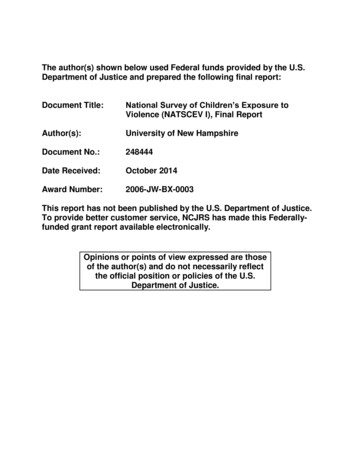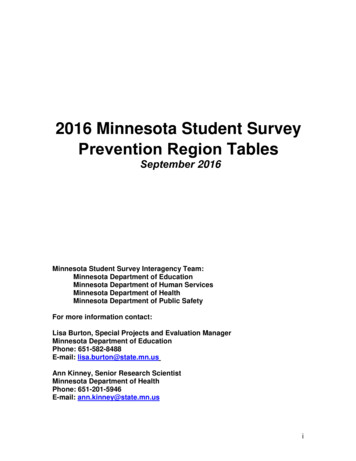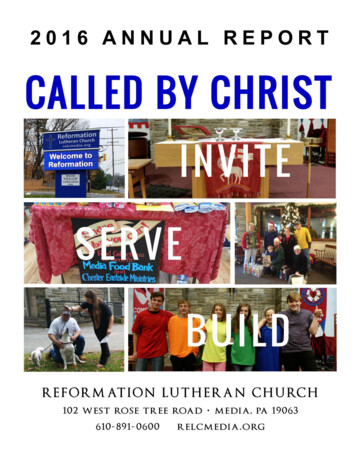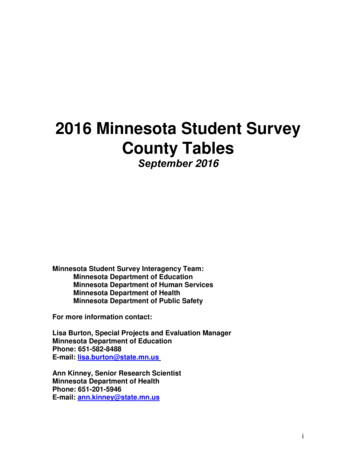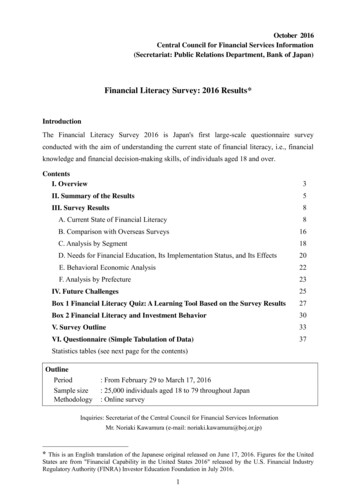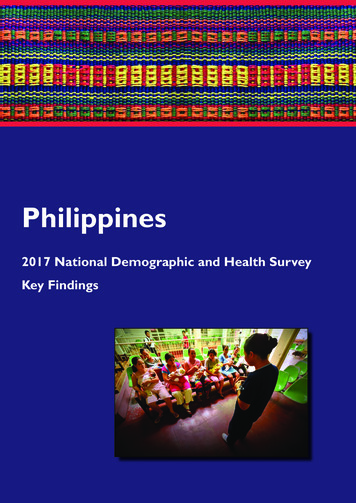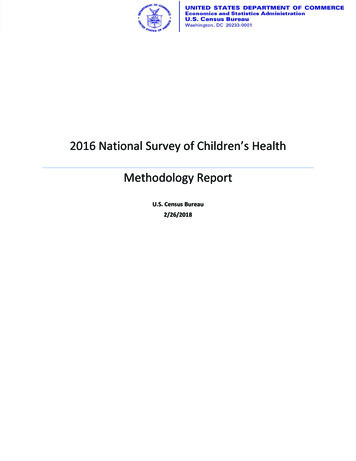
Transcription
2016 National Survey of Children’s HealthMethodology ReportU.S. Census Bureau2/26/20181
ContentsAbstract . 5Objectives. 5Methods . 5Results . 5Introduction . 6Survey History . 7Challenges faced by NSCH/NS‐CSHCN and Redesign . 7Frame, Sample, and Subsampling Specifications . 9Overview of the Key Sampling Processes . 9Frame Development . 10Sample Size and Allocation . 11Subsampling Specifications: Selection of Sampled Child . 12Instrument Specifications . 14Content Development. 14Survey Content. 14Web Instrument Specifications . 16Programming the Web Instrument . 17Paper Instrument Specifications . 17Data Collection . 19Mailout Specifications . 19Telephone Questionnaire Assistance (TQA) . 22Email Questionnaire Assistance (EQA). 23Respondent Demographics . 23Confidentiality . 24Spanish Language Availability . 24Efforts to Maximize Response Rates. 24Response Analysis . 26Response Rates . 26Response Rates by State . 28Web Survey Breakoffs . 28Item Level Response and Skip Patterns . 31Incentive Effort . 37Branding Effectiveness . 41Web Group Effectiveness. 41Data Editing . 43Unduplication . 43Paper to Web Standardization . 44Data Processing . 44Recoded and Standardized Variables . 46Weighting Plan . 54Overview . 54Population Controls . 57Limitations. 57Imputation . 59Overview of Missing Data . 59Imputed Variables and Flags . 592
Multiple Imputation . 60Estimation and Hypothesis Testing . 61Variance Estimation . 61Guidelines for Data Use . 61Supporting Material . 63References . 63Attachment A – 2016 NSCH Sample Sizes, by Stratum and by State . 64Attachment B – Child with Special Health Care Needs Question Battery . 65Attachment C ‐ Completed Screeners and Topicals and Weighted Response Rates by State . 66Attachment D – Summary of Last Raking Result before Final Trimming . 68Attachment E – Invitation Letters . 70Attachment F – Survey Questionnaires . 713
Table of FiguresTable 1. Anticipated Returns from the 2016 NSCH. 11Table 2. Strategies for Selecting the 2016 NSCH Sample Child . 13Table 3. Web Submission Times (in minutes) . 16Table 4. Screener Mailout Schedule . 20Table 5. Topical Mailout Schedule . 21Table 6. TQA Purpose Codes used in ATAC System . 22Table 7. Respondent Relation to Selected Child . 23Table 8. Final Disposition of Screener and Topical Returns . 27Table 9. Breakoffs by Survey Section . 29Table 10. Breakoffs by Survey Web Page (breakoffs 200) . 30Table 11. Item Response Rate below 95%, p .05 . 32Table 12. Item Response Rates for Yes/No Series, by Mode . 33Table 13. Item Response by Mode, where abs(Web‐Paper) .05 . 36Table 14. Treatment Group by Incentive Amount, Mailing Logo Branding, and Web Response Likelihood. 37Table 15. Response by Incentive Group. 38Table 16. Mailing Costs by Incentive Group . 38Table 17. Cost Effectiveness of Data Collection Strategies. 39Table 18. Topical Response by Mail Group and Incentive . 40Table 19. Data Collection for High Web vs. Low Web Addresses . 41Table 20. Unduplication Criteria for both Web and Paper Returns. 43Table 21. Unduplication Criteria for Two Paper Returns . 44Table 22. List of Standardized Variables . 46Table 23. List of Recoded Variables . 46Table 24. List of Suppressed Variables . 51Table 25. List of Geography Variables. 52Table 26. Geographies Identified at the Intersections . 52Table 27. Collapsed Dimensions and Affected States . 57Table 28. List of Imputed Variables. 59Table 29. List of Imputation Flags and Frequencies. 59Figure 1. Probability of Nonresponse to SLEEPPOS by Age of Child in Months. 344
AbstractObjectivesThis report details the development, plan, and operation of the 2016 National Survey of Children’sHealth (NSCH). This survey is designed to provide national and state‐level estimates on key indicators ofthe health and well‐being of children, their families and their communities, as well as information aboutthe prevalence and impact of special health care needs. Funding and direction for this survey wasprovided by the Health Resources and Services Administration’s Maternal and Child Health Bureau(HRSA MCHB) within the U.S. Department of Health and Human Services. The U.S. Census Bureauconducted the survey on behalf of HRSA MCHB.MethodsA sample of 364,150 households was selected from the Census Master Address File and allocated acrossthe 50 states and the District of Columbia. The sample was stratified by state and a child‐presenceindicator that allowed the Census Bureau to oversample households that were more likely to havechildren. The child‐presence indicator was developed by the Census Bureau’s Center for AdministrativeRecords Research and Applications and builds on multiple sources of administrative data.During data collection, a screener was first used to identify households with children. If children werepresent, the respondent created a roster of children in the household. The roster included the age andother demographics of each child as well as a battery of questions designed to identify children withspecial health care needs. After completing this screener component of the survey, one child wasrandomly selected from all children in each household to be the subject of an age‐specific topical survey.The respondent was a parent or guardian who knew about the child’s health and health care needs.ResultsThe weighted Overall Response Rate for the 2016 NSCH was 40.7%. A total of 138,009 screenerquestionnaires were completed from June 2016 to January 2017, and 67,047 of those were eligible fortopical questionnaire follow‐up. Of those topical‐eligible households, 50,212 completed the topicalquestionnaire. Weighted estimates from the Topical file generalize to state and national resident childpopulations. Weighted estimates from the Screener file generalize to state and national resident childpopulations (using the child weight) and households with children by state and nationally (using thehousehold weight).5
IntroductionThe 2016 National Survey of Children’s Health (NSCH) was conducted by the U.S. Census Bureau for theMaternal and Child Health Bureau (MCHB), Health Resources and Services Administration (HRSA),Department of Health and Human Services. As stated in the Office of Management and BudgetClearance Package, the purpose of the NSCH is to “collect information on factors related to the well‐being of children, including access to and quality of health care, family interactions, parental health,school and after‐school experiences, and neighborhood characteristics.” This document details theobjectives, methodologies, and results of the 2016 NSCH. It is organized in 9 sections. Survey History. The 2016 NSCH is the first production implementation following the redesignand merging of the previous NSCH and National Survey of Children with Special Health CareNeeds.Frame, Sample, and Subsampling Specifications. A screener instrument identified householdswith children and enumerated the children in those households. The topical instrumentcollected detailed information about one child selected at random from the household.Content Development and Instrument Specifications. Data were collected using a two‐stagepaper survey instrument and a single‐stage web‐based survey instrument.Data Collection. This section discusses the mail schedule and data capture methods for web,paper, and telephone questionnaire assistance operations.Response Analysis. This section discusses the calculation of response rates along with analysis ofsurvey breakoffs, item nonresponse, and treatment group comparisons.Data Processing and Editing. Web and paper survey responses were unduplicated, standardizedacross modes, and prepared for analysis.Weighting Specifications. Weights allow for generalizations of state and national child residentpopulations (Screener and Topical file) and households with children (Screener file).Imputation Specifications. Missing values were imputed for a subset of variables used ascontrols in weighting and as inputs in estimating the family poverty ratio.Estimation and Data Usage. This section discusses best practices for data users and limitations ofthe 2016 NSCH.6
Survey HistoryThe Health Resources and Services Administration’s Maternal and Child Health Bureau (HRSA MCHB),within the U.S. Department of Health and Human Services (HHS), has sponsored the National Survey ofChildren’s Health (NSCH)1 and its companion survey, the National Survey of Children with Special HealthCare Needs (NS‐CSHCN),2 since 2001. HRSA MCHB has provided funding and direction for the twoperiodic surveys in order to provide both national and state estimates of key indicators of child healthand well‐being for children ages 0‐17 years.Together, these surveys have provided critical data on key measures of child health; the presence andimpact of special health care needs; health care access, utilization, and quality; and the family andcommunity factors that impact child and adolescent health and well‐being. Both surveys were fieldedthree times (NS‐CSHCN 2001, 2005‐06, and 2009‐10; NSCH 2003, 2007, and 2011‐12) as modules of theState and Local Area Integrated Telephone Survey (SLAITS) system by the Centers for Disease Controland Prevention’s National Center for Health Statistics. As part of the SLAITS system, the surveys utilizeda random‐digit‐dial sample of landline telephone numbers, with cell‐phone supplementation in the lastyear of administration for both surveys.While the geographic representation, sample size, and content breadth remained significant strengthsof the surveys, over time HRSA MCHB and its stakeholders came to realize that a redesign of the twosurveys was warranted. Declining response rates along with the declining proportion of households inthe U.S. with landline telephones led to the decision to change the underlying sampling frame fromtelephone numbers to household addresses. Efforts were made to address this trend through theaddition of a cell‐phone frame to the last administration of both the NSCH and the NS‐CSHCN. However,consistent with industry‐wide challenges, the inclusion of cell‐phone samples proved to be both costlyand inefficient.In 2015, HRSA MCHB redesigned the NSCH and the NS‐CSHCN into a single combined survey that utilizedan Address‐Based Sampling frame. This newly consolidated survey incorporated questions from both ofthese surveys and retained the NSCH name. The U.S. Census Bureau now conducts the NSCH on thebehalf of HRSA MCHB and HHS under Title 13, United States Code, Section 8(b), which allows the CensusBureau to conduct surveys on behalf of other agencies.Challenges faced by NSCH/NS‐CSHCN and RedesignThe telephone interview methodology utilized for the NSCH and NS‐CSHCN allowed for a complexquestionnaire as it ensured that skip patterns were properly followed. Furthermore, it protected against1Blumberg SJ, Foster EB, Frasier AM, et al. 2012. Design and Operation of the National Survey of Children’s Health,2007. National Center for Health Statistics. Vital Health Stat, 1(55).http://www.cdc.gov/nchs/data/series/sr 01/sr01 055.pdf2Bramlett MD, Blumberg SJ, Ormson AE, et al. 2014. Design and Operation of the National Survey of Children withSpecial Health Care Needs, 2009–2010. National Center for Health Statistics. Vital Health Stat, 1(57).http://www.cdc.gov/nchs/data/series/sr 01/sr01 057.pdf7
data entry error through preprogrammed range and logic checks on responses. Interviewers were ableto address respondent questions and concerns as they arose, helping reduce response error. However,in recent years declining willingness of the public to participate in surveys and changes in householdtelephone use resulted in declining response rates for Computer‐Assisted Telephone Interviewingsurveys.3 Of particular concern was the increasing prevalence of households that had substitutedwireless service for their landline telephone. Efforts to include these non‐landline households within thetelephone sampling frames for the former NSCH and NS‐CSHCN through the addition of cell‐phones tothe frame were ultimately not cost efficient or effective. Furthermore, because the former NSCH andNS‐CSHCN were administered using the Centers for Disease Control and Prevention’s NationalImmunization Surveys (NIS) sampling frame and followed behind the NIS interview, they experiencedadditional impacts in response rates when cases failed to move through the NIS itself.The surveys were no longer sustainable in the face of declining response rates and rising costs.Therefore, considerable work was done to determine how to address these concerns, and the decisionwas reached to utilize a two‐phase multimode data collection design for a combined NSCH/NS‐CSHCNsurvey, henceforth known as the NSCH. The proposed approach to data collection and nonresponsefollow‐up was based on previous project experience and recommendations made by Dillman andcolleagues (2009).4The redesigned NSCH consists of two questionnaires: (1) an initial household screener to assess thepresence of children in the home and facilitate the selection of a target child within the household (withoversampling of children with special health care needs and young children ages 0‐5 years), and (2) asubstantive topical questionnaire that combines selected content from the former NSCH and NS‐CSHCNquestionnaires along with some newly relevant content.In 2015, the U.S. Census Bureau conducted a pretest of this redesign on behalf of HRSA MCHB. Thepretest was a one‐time national data collection activity, based on a national sample of 16,000 addresses,to evaluate and refine survey methodology, the survey instruments, and the operation procedures andprocesses used in the 2016 production survey.3Blumberg SJ, Luke JV. 2010. Wireless Substitution: Early Release of Estimates from the National Health InterviewSurvey, January–June 2010. National Center for Health Statistics. Available from:http://www.cdc.gov/nchs/nhis.htm4Dillman DA, Smyth JD, Christian LM. 2009. Internet, Mail and Mixed‐Mode Surveys: The Tailored Design Method,3rd edition. Hoboken, NJ: John Wiley & Sons.8
Frame, Sample, and Subsampling SpecificationsThe 2016 NSCH used an address‐based sample covering the 50 states and the District of Columbia.Addresses were randomly sampled within states, with a roughly equal number of addresses selectedwithin each state, as described in the Frame Development sub‐section below. Administrative recordsfrom multiple sources were utilized to match a list of child identifiers to residential addresses. When achild identifier was matched to an address, the address was flagged as being more likely to includechildren and designated as ‘Stratum 1’; the remaining addresses were designated as ‘Stratum 2’.Addresses in Stratum 1 were sampled at a higher rate than those in Stratum 2.If a household reported more than one child, the age and special health care needs status of thosechildren were used to select a single child from the household and assign the household to receive oneof the three age‐based topical questionnaires: T1 for 0 to 5 year old children, T2 for 6 to 11 year oldchildren, or T3 for 12 to 17 year old children. The subsampling of a single child from a household wasrandom, but children with special health care needs and young children (0 to 5 years old) had a higherprobability of selection. To limit respondent burden, no more than one child was sampled and no morethan one topical survey was administered in any given household.The target population for the NSCH consisted of children ages 17 or younger. Households were firstmailed an invitation to respond to the survey using the web instrument, but were given the option torespond to a paper instrument through nonresponse follow‐up. Addresses flagged as Low Web – the30% of addresses with the lowest probability of responding by web – received a paper instrumentsooner in nonresponse follow‐up. The methodology for assigning addresses to High Web and Low Webmailing groups is discussed in the Results Analysis section, Web Group Effectiveness sub‐section, below.One third of the sample received a 5 bill and one third received a 2 bill with the initial invitation as anincentive to complete the survey. One third of the sample did not receive an incentive and representedthe control group for testing the effectiveness of the two incentive treatments. Also, in the secondfollow‐up mailing, half of the sample received materials with HRSA MCHB branding while the other halfreceived materials with Census Bureau branding to test the effect of logo branding on response.Overview of the Key Sampling Processes Initial Sample Size and Treatment Groupso Sample Size: 364,150 addresses nationwideo 5,871 (Minnesota) to 9,490 (Hawaii) addresses per stateo Treatment Groups:o Incentive Groups 0 (control): 121,346 (33%) 2 bill: 121,420 (33%) 5 bill: 121,384 (33%)o Logo Branding Groups Census: 182,046 (50%) HRSA MCHB: 182,104 (50%)9
Web Groups High Web: 254,618 (70%) Low Web: 109,532 (30%)Initial Sample Stratification and Selection:o 222,750 (61%) addresses from Stratum 1 (Flagged as households with children)o 141,400 (39%) addresses from Stratum 2 (Not flagged)Selection of the Sample Childo Oversample children with special health care needs (CSHCN): 80%(Note that the 80% oversample was only applied for those households having both CSHCNand Non‐CSHCN present.)o Oversample young children (0 to 5 years old): 60%(Note that the 60% oversample was only applied for those households having all or noCSHCN.)o Frame DevelopmentThe 2016 NSCH utilized a sample of 364,150 household addresses randomly drawn from the CensusMaster Address File (MAF), a complete listing of all known living quarters in the 50 states and theDistrict of Columbia that is used to support the decennial census. The Census Bureau’s Center forAdministrative Records Research and Applications (CARRA) appended indicators to the MAF to sort andstratify the sample.The sample file was selected from the Census MAF and supplemented with an administrative recordsbased flag identifying households likely to include children. CARRA developed this child indicator basedon multiple sources of administrative data which were used for the first time to identify householdsmore likely to have children, to improve sampling efficiency in the NSCH.The child‐presence flag was used to create two mutually exclusive sampling strata: Stratum 1 (flaggedaddresses) and Stratum 2 (all other addresses). The sample sizes were allocated based on the relativesizes of Stratum 1 and Stratum 2, and the efficiency of the flag (i.e., the probability that a flaggedhousehold did have children) in each state. State‐level samples were allocated to produce an equalnumber of completed topical interviews in each state and the District of Columbia. Nationally, 61% ofthe sample was drawn from Stratum 1. This represents an average oversample ratio of about 5.2:1 forStratum 1 versus Stratum 2.Within strata, addresses were sorted by receipt of Supplemental Security Income (SSI) benefits (inStratum 1 only) and the block group5 poverty rate (greater than 30% or less than or equal to 30%) withthe net result that addresses within states were listed in the following order for sampling: Stratum 1: Households with the ‘child present’ flag5A Census block group is a geographical unit with 600 to 3,000 population. Census blocks are grouped into blockgroups; block groups, in turn, are grouped into Census tracts. The block group is the smallest scale geographicalunit for which the Census Bureau publishes sample statistics, i.e., estimates based on a sample of residents in theblock group. Consequently, it is the smallest scale geographical unit that could be used for this exercise.10
o SSI benefit recipientso Addresses in high poverty block groups, but not SSI benefit recipientso Remaining Stratum 1 householdsStratum 2: Households without the ‘child present’ flago Addresses in high poverty block groupso Remaining Stratum 2 households Sample Size and AllocationState sample sizes were determined objectively to produce an equal number of completed topicals perstate while summing to a total sample of 364,150 addresses nationwide (see Table 1). For a sampledaddress to complete the topical, it must complete each of the following stages: 1) it must be a validresidential address, 2) the residents must complete the screener, 3) the screener must report thatchildren are present and the age for at least one child, and 4) the topical‐eligible household mustcomplete the topical. Before mailing, we estimated screener and topical response rates using responserates from the 2015 Pretest. We audited the CARRA child‐p
within the U.S. Department of Health and Human Services (HHS), has sponsored the National Survey of Children's Health (NSCH)1 and its companion survey, the National Survey of Children with Special Health Care Needs (NS‐CSHCN),2 since 2001. HRSA MCHB has provided funding and direction for the two
